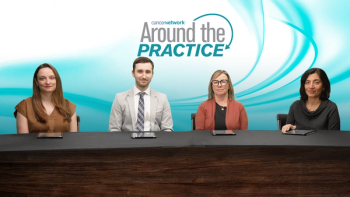Articles by Samuel Rosner, MD

Panelists discuss how a 69-year-old woman with newly diagnosed EGFR-mutant mNSCLC and symptomatic brain metastases requires immediate multidisciplinary care including steroids, radiation oncology consultation, and potential hospitalization, with treatment approach favoring stereotactic radiosurgery for dominant lesions followed by combination therapy like FLAURA2, while emphasizing that asymptomatic patients might allow for initial tyrosine kinase inhibitor treatment with close monitoring before considering radiation to potentially reduce treatment field and minimize long-term neurotoxicity.

Panelists discuss how treatment decisions for a 45-year-old avid rock climber with EGFR-mutant mNSCLC and liver metastases must balance his need to maintain work and income with optimal cancer care, considering his travel requirements and quality of life preferences, while acknowledging that the presence of TP53 comutations would suggest more aggressive disease requiring consideration of combination therapy despite potential lifestyle impacts, and that MET overexpression in the second-line setting offers targeted options like tepotinib or capmatinib.

Panelists discuss how retreatment with platinum doublet chemotherapy after FLAURA2 progression is considered as a potential option when patients have been chemotherapy-free for at least 6 months (using platinum sensitivity principles), with clinicians preferring to exhaust all targeted therapies and considering newer agents like datopotamab deruxtecan first, while acknowledging that retreatment with chemotherapy represents a safety net option for patients who remain fit enough to tolerate it.

Panelists discuss how the decision to continue targeted TKI therapy in the second-line setting depends on multiple factors including intracranial progression status, extent of disease progression, prior radiation therapy, and individual patient circumstances, with clinicians preferring to continue TKI for isolated CNS progression that can be managed with radiation while switching to different regimens for widespread progression or recurrent intracranial disease after prior radiation.

Panelists discuss how their approach to second-line treatment decision-making prioritizes biomarker-directed therapies over biomarker-agnostic approaches, with clinicians preferring to exhaust all targeted therapy options based on molecular alterations identified through rebiopsy and plasma testing before moving to tumor-agnostic treatments like datopotamab deruxtecan or docetaxel, emphasizing the importance of molecular matching for optimal patient outcomes.

Panelists discuss how tissue vs plasma biopsy strategies after first disease progression typically prioritize liquid biopsy due to convenience and improving technology, with tissue rebiopsy reserved for cases of rapid progression in multiple sites, clinical suspicion of transformation or resistance mechanisms not detected on liquid biopsy, or when oligoprogressive disease cannot be managed with local therapy, emphasizing that rebiopsy decisions should be based on whether results will change management.

Panelists discuss how the choice of frontline therapy influences future treatment options by requiring strategic planning for progression, with emphasis on using radiation for oligoprogressive disease to continue effective treatments, repeating genomic testing to assess resistance patterns, considering clinical trials, and utilizing multidisciplinary approaches including surgery for oligoresidual disease to potentially achieve curative outcomes in selected patients.

Panelists discuss how multidisciplinary collaboration with subspecialists, particularly dermatologists, is essential for managing cutaneous and other treatment toxicities associated with combination therapies like amivantamab and tyrosine kinase inhibitors, as dermatologists have become increasingly familiar with oncology-related toxicities and can provide specialized interventions when standard preventive measures fail, with access to academic medical centers offering additional expertise for complex cases.

Panelists discuss how the availability of subcutaneous amivantamab could be a game changer for clinical practice by lowering the threshold for using amivantamab plus lazertinib combination therapy, as it would decrease infusion-related reactions, reduce VTE risk, improve infusion center efficiency, and make the regimen more appealing to patients by offering an injection plus pill vs multiple intravenous chemotherapy medications plus pill.

Panelists discuss how toxicity discussions with patients must emphasize different adverse effects for each combination therapy, with osimertinib plus chemotherapy requiring focus on fatigue, cytopenias, and dermatologic toxicity, while amivantamab plus lazertinib requires discussion of infusion reactions, venous thromboembolism prophylaxis, and skin toxicities, though they acknowledge that complex prophylactic regimens can be challenging for patients with lower health literacy and may involve significant financial burden.

Panelists discuss how combination therapies create additional time and financial burdens compared with osimertinib monotherapy, with treatment requiring more frequent visits (every 3 weeks for FLAURA2, weekly then biweekly for amivantamab), and while some clinicians follow trial protocols to continue maintenance pemetrexed, others have a lower threshold to discontinue it to reduce time toxicity and improve quality of life, balancing patient preferences with potential treatment benefits.

Panelists discuss how the projected 1-year overall survival benefit from the amivantamab plus lazertinib combination in the MARIPOSA trial represents impressive and meaningful progress for patients with incurable disease, with the hazard ratio of 0.75 being a significant deciding factor for many patients, though they acknowledge the complexity of interpreting this benefit given the lack of crossover in the trial and uncertainty about optimal sequencing strategies.

Panelists discuss how maintaining quality of life must be balanced with efficacy in metastatic lung cancer patients, emphasizing the importance of early intervention for adverse events through patient education, frequent follow-up visits (including day 8 and day 15 visits), close monitoring with laboratory checks, and proactive communication via nursing and pharmacy teams to ensure patients can stay on therapy longer and derive maximum clinical benefit.

Panelists discuss how resistance mechanisms influence frontline therapy selection, with clinicians considering comutational status, brain and liver involvement, and disease burden when choosing combination therapies, while acknowledging the chess-like strategic thinking required to balance optimal progression-free survival with future treatment options, especially given that 25% to 30% of patients may not receive second-line therapy.

Panelists discuss how choosing between the 2 combination therapies (osimertinib plus chemotherapy vs amivantamab plus lazertinib) involves considerations of familiarity and comfort level, with many clinicians favoring the more familiar chemotherapy plus osimertinib approach while acknowledging that having different mechanistic options provides valuable sequencing flexibility for future treatment decisions.

Panelists discuss how patient preferences for EGFR-mutant mNSCLC treatment vary widely based on medical literacy, information-seeking behavior, and prior experiences, with clinicians emphasizing the importance of shared decision-making, understanding patients’ reasoning behind their preferences, and meeting patients where they are in their knowledge and comfort level to formulate treatment plans that align with their goals of care.

Panelists discuss how treatment decisions between osimertinib monotherapy and combination therapy should be individualized based on patient factors including performance status, medical comorbidities, frailty, age, patient preferences for quality of life vs aggressive treatment, and genomic features such as comutations or resistance mechanisms, with shared decision-making playing a crucial role given the incurable nature of the disease.

Panelists discuss how combination therapy with osimertinib plus chemotherapy or amivantamab plus lazertinib is being evaluated as a potential new frontline treatment standard for EGFR-mutant metastatic NSCLC, with treatment decisions requiring individualized approaches based on patient characteristics, disease burden, comorbidities, and quality of life considerations rather than a universal preferred regimen.

Samuel Rosner, MD, discusses how the treatment landscape for EGFR-mutated non–small cell lung cancer has evolved from first-generation targeted therapies to osimertinib as the current standard of care, while exploring emerging options like fourth-generation tyrosine kinase inhibitors, antibody-drug conjugates, and bispecific therapies to overcome resistance mechanisms.

Complex ES-SCLC Case: Tarlatamab Management Through Toxicity to Clinical Benefit
BySamuel Rosner, MD,Ranee Mehra, MD,Michelle Sittig, RN, OCN ,Kaitlyn Whyman, DNP, CRNP, AGACNP-BC Panelists discuss how effective management of cytokine release syndrome and immune effector cell–associated neurotoxicity syndrome in complex extensive-stage small cell lung cancer (ES-SCLC) cases treated with tarlatamab enables patients to continue therapy and achieve meaningful clinical benefit despite early toxicities.

Seamless Transitions: Managing the Inpatient to Outpatient Care Continuum
BySamuel Rosner, MD,Ranee Mehra, MD,Michelle Sittig, RN, OCN ,Kaitlyn Whyman, DNP, CRNP, AGACNP-BC Panelists discuss how best practices for transitioning from inpatient to outpatient care involve clear communication, regular monitoring, and adjusted visit frequencies, while addressing challenges such as care coordination and patient adherence to follow-up plans.

Future Research Priorities: Optimizing Tarlatamab Administration and Toxicity Management
BySamuel Rosner, MD,Ranee Mehra, MD,Michelle Sittig, RN, OCN ,Kaitlyn Whyman, DNP, CRNP, AGACNP-BC Panelists discuss how future research priorities for tarlatamab focus on optimizing administration, improving toxicity management, and enhancing patient selection, with an emphasis on minimizing adverse events while maximizing efficacy and evaluating long-term safety.

Standardized Toxicity Grading: Institutional Protocols for CRS and ICANS
BySamuel Rosner, MD,Ranee Mehra, MD,Michelle Sittig, RN, OCN ,Kaitlyn Whyman, DNP, CRNP, AGACNP-BC Panelists discuss how standardized toxicity grading for cytokine release syndrome and immune effector cell–associated neurotoxicity syndrome helps guide physicians in the timely management and escalation of care, emphasizing the importance of symptom grading and clear institutional protocols for intervention.

Differential Toxicity Profile: Tarlatamab vs Traditional Cytotoxic Therapies
BySamuel Rosner, MD,Ranee Mehra, MD,Michelle Sittig, RN, OCN ,Kaitlyn Whyman, DNP, CRNP, AGACNP-BC Panelists discuss how tarlatamab’s toxicity profile differs from traditional cytotoxic therapies, highlighting its immune-related adverse effects such as cytokine release syndrome and immune effector cell–associated neurotoxicity syndrome, while noting its lower risk of myelosuppression and long-term organ damage compared with chemotherapy, which tends to cause cumulative toxicities such as bone marrow suppression.

Nonimmune Adverse Effects: Managing Dysgeusia and Fatigue
BySamuel Rosner, MD,Ranee Mehra, MD,Michelle Sittig, RN, OCN ,Kaitlyn Whyman, DNP, CRNP, AGACNP-BC Panelists discuss how the assessment and management of immune effector cell–associated neurotoxicity syndrome involves grading symptoms from mild to life-threatening, emphasizing the need for prompt recognition and rapid intervention to prevent progression and minimize long-term neurological damage.

CRS Recognition and Intervention: Timing and Clinical Features
BySamuel Rosner, MD,Ranee Mehra, MD,Michelle Sittig, RN, OCN ,Kaitlyn Whyman, DNP, CRNP, AGACNP-BC Panelists discuss how recognizing and grading cytokine release syndrome (CRS) based on symptoms ranging from mild flulike effects to life-threatening conditions is essential for timely intervention, with early detection being key to managing CRS effectively and preventing progression to severe stages.

Neurological Toxicity Recognition: ICANS Assessment and Management
BySamuel Rosner, MD,Ranee Mehra, MD,Michelle Sittig, RN, OCN ,Kaitlyn Whyman, DNP, CRNP, AGACNP-BC Panelists discuss how the assessment and management of immune effector cell–associated neurotoxicity syndrome involves grading symptoms from mild to life-threatening, emphasizing the need for prompt recognition and rapid intervention to prevent progression and minimize long-term neurological damage.

Essential Patient and Caregiver Education for Tarlatamab Treatment Success
BySamuel Rosner, MD,Ranee Mehra, MD,Michelle Sittig, RN, OCN ,Kaitlyn Whyman, DNP, CRNP, AGACNP-BC Panelists discuss how education materials for tarlatamab include detailed treatment overviews, potential adverse effects, and monitoring requirements, while emphasizing the importance of ensuring that patients and caregivers fully understand the information and can recognize early signs of adverse reactions.

Tarlatamab Administration and Postinfusion Monitoring
BySamuel Rosner, MD,Ranee Mehra, MD,Michelle Sittig, RN, OCN ,Kaitlyn Whyman, DNP, CRNP, AGACNP-BC Panelists discuss how tarlatamab is administered via intravenous infusion with gradual dosing increases, emphasizing the importance of immediate postinfusion monitoring for acute reactions such as cytokine release syndrome, followed by ongoing follow-up to detect delayed adverse effects and manage potential immune-related toxicities.

Patient Selection Criteria: Identifying Appropriate Candidates for Tarlatamab
BySamuel Rosner, MD,Ranee Mehra, MD,Michelle Sittig, RN, OCN ,Kaitlyn Whyman, DNP, CRNP, AGACNP-BC Panelists discuss how tarlatamab eligibility is determined based on clinical factors such as prior treatment history, organ function, and ECOG performance status, with particular attention to how previous therapies, such as chimeric antigen receptor T-cell therapy or chemotherapy, may affect eligibility and immune system response.







